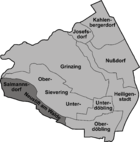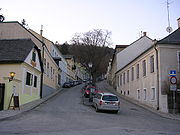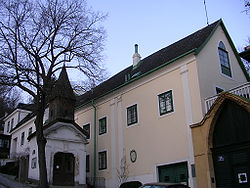
Salmannsdorf
Encyclopedia
| Sievering | |
|---|---|
| Coat of arms | Map |
 |
 |
Location: 48°15′18"N 16°21′30"E |
|
Salmannsdorf is today a part of Döbling
Döbling
Döbling is the 19th District in the city of Vienna, Austria . It is located on the north end from the central districts, north of the districts Alsergrund and Währing...
, the 19th district of Vienna
Vienna
Vienna is the capital and largest city of the Republic of Austria and one of the nine states of Austria. Vienna is Austria's primary city, with a population of about 1.723 million , and is by far the largest city in Austria, as well as its cultural, economic, and political centre...
.
Salmannsdorf was an independent municipality
Municipality
A municipality is essentially an urban administrative division having corporate status and usually powers of self-government. It can also be used to mean the governing body of a municipality. A municipality is a general-purpose administrative subdivision, as opposed to a special-purpose district...
until 1892, when it was incorporated into the Währing
Währing
Währing is the 18th district of Vienna, Austria. It is in the northwest part of the city. In addition to currently hosting a number of Vienna's foreign embassies, Währing was the site of the original burial places of composers Ludwig van Beethoven and Franz Schubert.-Location:Währing lies in the...
district of the city of Vienna. However, in 1938, Salmannsdorf was re-assigned together with Neustift am Walde
Neustift am Walde
Until 1892 Neustift am Walde was an independent municipality in the outskirts of Vienna, Austria and is today a part of Döbling, the 19th district of Vienna...
to the district of Döbling
Döbling
Döbling is the 19th District in the city of Vienna, Austria . It is located on the north end from the central districts, north of the districts Alsergrund and Währing...
.
Salmannsdorf lies along the western border of Sievering
Sievering
Sievering is a suburb of Vienna and part of Döbling, the 19th district of Vienna. Sievering was created in 1892 out of the two erstwhile independent suburbs Untersievering and Obersievering. These still exist as Katastralgemeinden.- Geography :...
. It is one of the 10 municipalities in the district of Döbling
Döbling
Döbling is the 19th District in the city of Vienna, Austria . It is located on the north end from the central districts, north of the districts Alsergrund and Währing...
.
Geography

Vienna
Vienna is the capital and largest city of the Republic of Austria and one of the nine states of Austria. Vienna is Austria's primary city, with a population of about 1.723 million , and is by far the largest city in Austria, as well as its cultural, economic, and political centre...
and is part of the district of Döbling
Döbling
Döbling is the 19th District in the city of Vienna, Austria . It is located on the north end from the central districts, north of the districts Alsergrund and Währing...
. Salmannsdorf lies on the southern slope of Dreimarkstein hill, in the valley of the Krottenbach stream. The Katastralgemeinde
Katastralgemeinde
A Katastralgemeinde , a German word , is a cadastral subdivision of municipalities in the nations of Austria, Croatia, the Czech Republic, Slovakia, the Italian provinces of South Tyrol, Trentino, Gorizia, Trieste, and in Slovenia.A cadastral community records property ownership in a cadastre,...
stretches across an area of 66.05 hectares. The region is part of the statistical census-district of Salmannsdorf-Glanzing. In the south, Salmannsdorf borders on Neustift am Walde
Neustift am Walde
Until 1892 Neustift am Walde was an independent municipality in the outskirts of Vienna, Austria and is today a part of Döbling, the 19th district of Vienna...
; in the east, on Obersievering
Sievering
Sievering is a suburb of Vienna and part of Döbling, the 19th district of Vienna. Sievering was created in 1892 out of the two erstwhile independent suburbs Untersievering and Obersievering. These still exist as Katastralgemeinden.- Geography :...
. The border in the west divides it from Neuwaldegg; in the north lies the Dreimarkstein hill, with the border to Hinterweidling in Lower Austria
Lower Austria
Lower Austria is the northeasternmost state of the nine states in Austria. The capital of Lower Austria since 1986 is Sankt Pölten, the most recently designated capital town in Austria. The capital of Lower Austria had formerly been Vienna, even though Vienna is not officially part of Lower Austria...
.
The origin of the name Salmannsdorf
Salmannsdorf was first mentioned in 1279 as Salmanstorf. The name derives either from the personal name Salman or the professional title Salmann (a trustee or clerk).Salmannsdorf in modern times

Battle of Vienna
The Battle of Vienna took place on 11 and 12 September 1683 after Vienna had been besieged by the Ottoman Empire for two months...
. In 1683, Salmannsdorf was completely destroyed. Two major outbreaks of fire did further damage in the ensuing years. The village had just 18 houses when the plague struck in 1713, killing 74 of the 118 inhabitants. 120 years later, Salmannsdorf had still barely exceeded its former size.
Salmannsdorf first began to grow around the middle of the 19th century, when, like its neighbour Neustift am Walde
Neustift am Walde
Until 1892 Neustift am Walde was an independent municipality in the outskirts of Vienna, Austria and is today a part of Döbling, the 19th district of Vienna...
, it profited from tourists attracted by its fine summer weather. Salmannsdorf was not overly popular with Vienna’s wealthy families, but regular visitors between 1829 and 1832 included the family of Johann Strauß the Elder. A plaque at number 13 in the Dreimarksteingasse celebrates the fact that Johann Strauß the Elder wrote his first waltz
Waltz
The waltz is a ballroom and folk dance in time, performed primarily in closed position.- History :There are several references to a sliding or gliding dance,- a waltz, from the 16th century including the representations of the printer H.S. Beheim...
here. In 1890, there were 312 people living in 94 houses in Salmannsdorf.
In 1892, Salmannsdorf, along with the surrounding suburbs of Neustift am Walde
Neustift am Walde
Until 1892 Neustift am Walde was an independent municipality in the outskirts of Vienna, Austria and is today a part of Döbling, the 19th district of Vienna...
, Währing, Weinhaus, Gersthof and Pötzleinsdorf was integrated into Vienna as the district of Währing
Währing
Währing is the 18th district of Vienna, Austria. It is in the northwest part of the city. In addition to currently hosting a number of Vienna's foreign embassies, Währing was the site of the original burial places of composers Ludwig van Beethoven and Franz Schubert.-Location:Währing lies in the...
. In a reorganisation of the district boundaries in 1938, Salmannsdorf and Neustift am Walde were assigned to the 19th district, Döbling
Döbling
Döbling is the 19th District in the city of Vienna, Austria . It is located on the north end from the central districts, north of the districts Alsergrund and Währing...
.
Economy

Rail, road and bus links
Originally, there was a wagon train that passed through Neustift to Salmannsdorf, with varying destinations in the city over the years. For financial reasons, the operation of this transport link also changed hands several times, even though it was the only such connection to receive subventions from the City of Vienna. In 1908, the Wiener LinienWiener Linien
Wiener Linien are the company running the largest part of the public transit network in the city of Vienna, Austria. They are part of the city corporation Wiener Stadtwerke Holding AG.- Governing structure and statistics :...
introduced a trolleybus operating the Mercédès-Électrique-Stoll system from Pötzleinsdorf via Neustift am Walde to Salmannsdorf. This was one of the longest-serving routes using this system and it was only replaced in 1938 by an omnibus
Bus
A bus is a road vehicle designed to carry passengers. Buses can have a capacity as high as 300 passengers. The most common type of bus is the single-decker bus, with larger loads carried by double-decker buses and articulated buses, and smaller loads carried by midibuses and minibuses; coaches are...
with the route number 23. The route was however cancelled the following year.
In 1928, a bus running along the Krottenbachstraße to Neustift and Salmannsforf was introduced (from 1935 the number 20). Because this route took it past factories that were necessary for the war effort, this was the last bus route in Vienna that was still running in World War II. In 1942, preparations were made to introduce trolleybuses, which happened in 1946, but in 1958, motor-powered buses were re-introduced. From 1945 to 1961, this was the route number 22; thereafter and until 1972, it bore the number 39A, and since then, it has been the number 35A. This bus runs from the Spittelau station along the Krottenbachstraße via Neustift am Walde to its final destination in Salmannsdorf.

